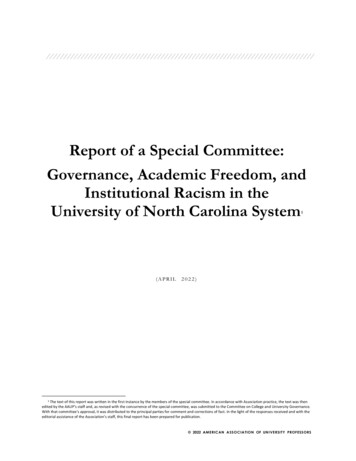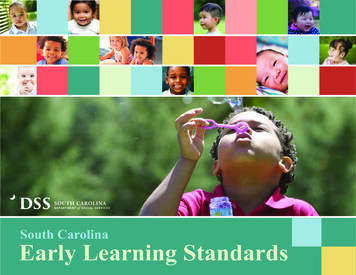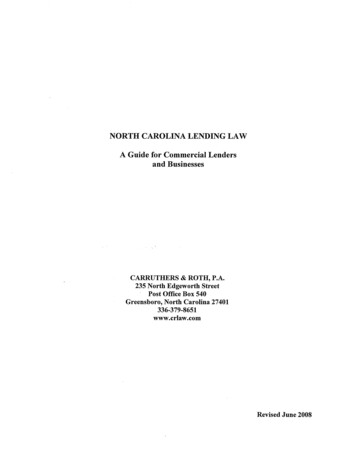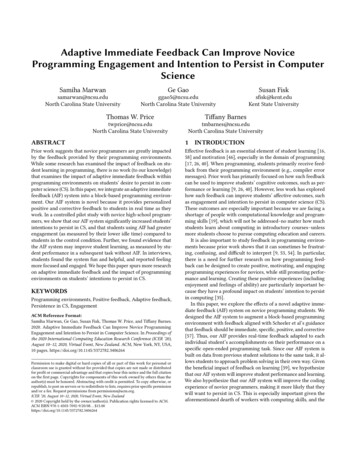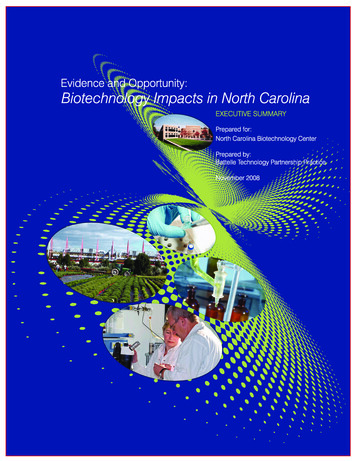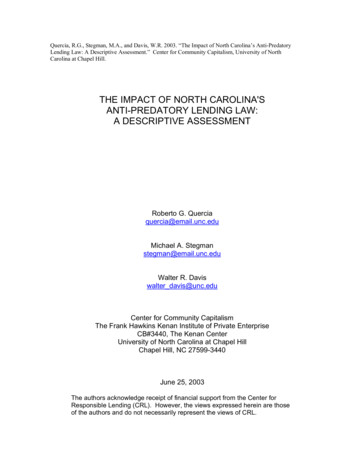
Transcription
Quercia, R.G., Stegman, M.A., and Davis, W.R. 2003. “The Impact of North Carolina’s Anti-PredatoryLending Law: A Descriptive Assessment.” Center for Community Capitalism, University of NorthCarolina at Chapel Hill.THE IMPACT OF NORTH CAROLINA'SANTI-PREDATORY LENDING LAW:A DESCRIPTIVE ASSESSMENTRoberto G. Querciaquercia@email.unc.eduMichael A. Stegmanstegman@email.unc.eduWalter R. Daviswalter davis@unc.eduCenter for Community CapitalismThe Frank Hawkins Kenan Institute of Private EnterpriseCB#3440, The Kenan CenterUniversity of North Carolina at Chapel HillChapel Hill, NC 27599-3440June 25, 2003The authors acknowledge receipt of financial support from the Center forResponsible Lending (CRL). However, the views expressed herein are thoseof the authors and do not necessarily represent the views of CRL.
The Impact of North Carolina’s Anti-Predatory Lending Law: A Descriptive AssessmentAbstractIn this study, we examine changes in subprime lending activity beforeand after the North Carolina Anti-Predatory Lending Law was implemented in1999 and 2000. Previous studies have noted a decline in overall subprimelending following the law’s enactment. We suggest that such a finding is to beexpected given that the purpose of the law was to reduce the number ofsubprime loan originations with predatory or abusive terms. To us, therelevant question is what component(s) of subprime lending declined, andwhich remained stable or increased after the law was implemented.Using an analysis database of 3.3 million subprime loans covering1998-2002, supplied to us under license by the company, Loan Performance,Inc., we find that the reduction in subprime originations observed from 1999 to2000 is due to a decline in the number of refinance originations, whilepurchase originations actually increased. Most importantly, we find a largedecline in subprime refinance originations with abusive or predatory terms.This is not unexpected since the law’s intent was to curtail this type of lending.Overall, we conclude that after the North Carolina predatory lending law wasfully implemented, the subprime market behaved essentially as the lawintended: There was a reduction in predatory loans but no change in the costof subprime credit or reduction in access to credit for high-risk borrowers.Center for Community Capitalism1
The Impact of North Carolina’s Anti-Predatory Lending Law: A Descriptive AssessmentIntroductionThe 1990s were characterized by the aggressive expansion of credit topopulations traditionally considered underserved, including those with limitedor impaired credit histories, such as many minorities and recent immigrants.Financial institutions became more active in this so-called subprime area as aresult of technological changes, a robust economy, and the need for newmarkets. Subprime borrowers have benefited from this expansion of credit,and institutions have seen profits increase through growth (Harvey and Nigro2002).In fact, subprime mortgage lending grew significantly over a very shortperiod of time. Across the country, the volume of subprime mortgageoriginations grew from 35 billion to about 213 billion in only 8 years (19942002) (Mortgage Market Statistical Annual 2003). This increase reflects thegrowing involvement of secondary market institutions such as Fannie Mae andFreddie Mac in securitizing subprime mortgages. Securitized subprime loansincreased from 11 billion to 83 billion from 1994 to 1999 (Harvey and Nigro2002).Subprime lending serves a wide range of borrowers, from those withminor credit imperfections to those with serious credit problems. In theory, thecost of borrowing increases as the quality of a borrower’s credit declines, withthe highest fees and rates charged to borrowers with the lowest credit quality.Problems may arise if unscrupulous lenders take advantage of uninformedCenter for Community Capitalism2
The Impact of North Carolina’s Anti-Predatory Lending Law: A Descriptive Assessmentborrowers by charging fees and rates not reflective of the risk, by notinforming borrowers of their least expensive loan alternatives, and by offeringproducts and services without full disclosure of terms and options.The term “predatory lending” refers to a set of abusive lendingpractices concentrated in the subprime sector. These include makingunaffordable loans based on the assets of the borrower rather than on theborrower’s ability to repay an obligation; inducing a borrower to refinance aloan, often repeatedly, in order to charge high points and fees on the refinance(“loan flipping”); and engaging in fraud and deception to conceal from anunsuspecting or unsophisticated borrower the true nature of the loan obligation(Gramlich 2000). For service providers, regulators, and legislators, dealingwith predatory lending requires a balancing act, because curbing thesepractices may curtail credit to some borrowers. Some borrowers may be souncreditworthy that they can only get credit under conditions that areconsidered predatory. Historically, however, government has acted to curbabusive lending practices even if the regulations limit the flow of certain kindsof credit.Predatory lending can have a devastating effect on families. Loansmade without regard to a borrower’s repayment ability are likely to erode theborrower’s home equity position. This is especially true for minority and lowincome families, for whom home equity comprises over 60 percent of their networth (State of the Nation’s Housing 2002). In addition, most olderCenter for Community Capitalism3
The Impact of North Carolina’s Anti-Predatory Lending Law: A Descriptive Assessmenthomeowners depend on equity to supplement other savings after retirement(Quercia 1997). The importance of home equity for these financiallyunsophisticated or vulnerable populations makes them potential targets ofpredatory practices (Carr and Kolluri 2001).In the absence of direct evidence, and because predatory lending islargely a subset of subprime lending, the potential for abuse can be deduced byobserving overall subprime lending patterns and changes over time. Forinstance, subprime loans are three times more likely in low-incomeneighborhoods than in high-income neighborhoods and five times more likelyin black neighborhoods than in white ones. Furthermore, homeowners in highincome black areas are twice as likely as homeowners in low-income whiteareas to have subprime loans. Similarly, subprime loans are three times morelikely among older borrowers than among younger borrowers (AARP 2003).These figures suggest that the negative impacts of abusive or predatorysubprime practices may fall most heavily on those who have less access toprime credit (HUD 2000).Unfortunately, there is no single, agreed-upon definition of whatconstitutes predatory lending. Those that exist are largely based on thedefinition of high-cost loans in the federal Home Ownership and EquityProtection Act (HOEPA) of 1994, which bans certain practices and requiresadditional disclosures and borrower protections. In 2000, about one percent ofall subprime mortgage loans was estimated to fall under HOEPA (GramlichCenter for Community Capitalism4
The Impact of North Carolina’s Anti-Predatory Lending Law: A Descriptive Assessment2000).1 By contrast, estimates of predatory lending and actual settlementsentered into by large subprime lenders suggest the true incidence may beconsiderably higher (for example, see Richardson 2003). Since 1994, severalstates and local jurisdictions have enacted HOEPA-like regulations andordinances, so that high-cost or predatory loans have come to be defined asloans featuring one or more specified terms and underwriting practices,including exorbitant points and fees, balloon payments, prepayment penalties,loan flipping, as well as not requiring adequate documentation of repaymentability, and including interest rates on real estate-secured loans in and abovethe credit card range.Critics have questioned whether legislative efforts to curb predatorypractices would also increase the cost of serving particular segments of themarket, reduce the supply of mortgage credit and raise the cost of borrowing(Elliehausen and Staten 2002 and 2003). Because North Carolina was the firststate to enact anti-predatory legislation, its 1999 Anti-Predatory Law hasreceived a great deal of attention. Examinations of the law’s impact to datehave had varied results.This study is the first in a series to be prepared by the Center forCommunity Capitalism, a research center based in the Kenan Institute ofPrivate Enterprise in the University of North Carolina at Chapel Hill, on the1In 2002, revisions to Regulation Z (Truth in Lending act) expanded the definition of highcost loans under HOEPA.Center for Community Capitalism5
The Impact of North Carolina’s Anti-Predatory Lending Law: A Descriptive Assessmentimpacts of the North Carolina law and other issues related to subprime lending;all of which are to be supported by a database of subprime loans licensed to usby the company, Loan Performance, Inc.This initial paper is entirely descriptive. We begin by enumerating thecharacteristics of the North Carolina Anti-Predatory Law and reviewing theliterature to assess what is known of its impacts. Next, we describe themethodology and data used in this study; we introduce the Loan Performancedatabase and compare subprime lending activities in the U.S., in selectedSouthern states, including North Carolina, and in the rest of the South. Weexamine changes in the number of subprime loans, both purchase andrefinance, before and after implementation of the North Carolina law. We alsoexamine changes in two measures that capture basic concerns about such laws:access to credit and the cost of credit for subprime borrowers. Next, weexamine changes in subprime refinance originations with characteristicsconsidered abusive or predatory.Prior work on the impacts of the North Carolina law has focused on theoverall subprime market. In contrast, the focus of our work is more properlyon the impact of the law on specific market segments and on the supply ofsubprime credit with abusive or predatory features. In the final section, wediscuss the directions for our future research.Center for Community Capitalism6
The Impact of North Carolina’s Anti-Predatory Lending Law: A Descriptive AssessmentThe North Carolina Anti-Predatory Law: What Do We Know?Enacted in 1999, North Carolina’s Anti-Predatory Lending Lawprohibits certain types of lending activities that are considered to bedetrimental to consumers.2 See Exhibit 1 for key characteristics of the law.The law was enacted in two phases. In the fourth quarter of 1999, threeelements of the law took effect. First, prepayment penalties were banned forloans up to 150,000. Second, permissible classes of fees were defined forloans secured by real property and for fees to be paid to third parties inassociation with the loan. Finally, consumer home loan refinancingtransactions were prohibited where they failed to provide a borrower with areasonable, tangible net benefit (the “no flipping” provision). The remainingrequirements of the law took effect on July 1, 2000.We have identified five studies that have examined the impacts of theNC law to varying degrees. The first, conducted by the trade publication,Inside B&C Lending (2001), reviewed rate sheets of several top subprimelenders to assess the range of products and prices offered in NC afterenactment of the law. This study finds that subprime lenders in North Carolinawere continuing to offer a full array of products and that there was little or novariation in rates charged. Moreover, while some companies opted to leave the2(S.B.1149, codified at NCGS 24-1.1E, 24-10.2; effective 7/1/00) (S.B.1149, codified atNCGS 24-1.1E, 24-10.2; effective 7/1/00).Center for Community Capitalism7
The Impact of North Carolina’s Anti-Predatory Lending Law: A Descriptive Assessmentmarket, the study concludes it was not clear what role, if any, the predatorylending law played in those decisions.Elliehausen and Staten (2002 and 2003) used loan-level data from ninemembers of the American Financial Services Association (AFSA) to comparesubprime lending originations in North Carolina to those in Virginia, SouthCarolina, and Tennessee. The authors find that the North Carolina law resultedin a decline in overall subprime originations and in originations to low-incomeborrowers ( 50,000 income) in North Carolina relative to the other twostates.Ernst, Farris, and Stein (2002) examined the volume of subprimeoriginations before and after enactment of the law using Home MortgageDisclosure Act (HMDA) data to compare 1999 and 2000 subprime originationsfor North Carolina with the rest of the nation. They find that there was anoverall decline in the subprime market in North Carolina between those twodates, but that North Carolina was still among the most active subprimeorigination markets in the nation. They also found that despite the overalldecline in subprime lending in North Carolina, the percentage of all subprimeoriginations to lower-income borrowers remained unchanged. On the basis ofthis finding, the authors conclude that the overall decline was not just in thelower-income portion of the market but was distributed across the incomespectrum. They also calculate that the law saved an estimated 100 million forNorth Carolina borrowers over the study period.Center for Community Capitalism8
The Impact of North Carolina’s Anti-Predatory Lending Law: A Descriptive AssessmentMorgan Stanley (2002) surveyed 280 subprime branch managers toassess the impact of predatory lending laws on lending activity across thecountry, and found that subprime residential lending volumes were not reducedin any significant way. The report specifically finds that “Even the toughestnew laws, in states like North Carolina for example, do not seem to beaffecting branch volumes” (Morgan Stanley: 2).Finally, Harvey and Nigro (2002) examined loan application and denialrates in North Carolina and neighboring states using 1998-2000 HMDA data.They find that the law reduced the overall level of subprime mortgage lendingactivity in North Carolina relative to Virginia, Tennessee, South Carolina, andGeorgia. However, they also report that the North Carolina decline was causedby a change in subprime loan application rates, not a change in denial rates.This suggests that the decline is a result of less demand rather than reducedsupply.Methodology and DataAs described above, all of the prior studies on the North Carolina AntiPredatory Law focus on the impacts of the law on the overall subprime market.In contrast, we think the focus should properly be on the impacts of the law onmarket segments and market practices targeted by the law; in other words, onthe law’s impacts on the incidence of loans with predatory or potentiallypredatory characteristics. Thus, if the law has its intended effects, we wouldCenter for Community Capitalism9
The Impact of North Carolina’s Anti-Predatory Lending Law: A Descriptive Assessmentexpect to find a decrease in subprime refinance originations, since mostpredatory loans are refinances, but not in purchase originations. We wouldalso expect to find a decrease in refinance loans with abusive or predatoryfeatures, such as long-term prepayment penalties, balloon payments, and loanswith combined loan-to-value ratios (LTV) for second lien refinances over 110percent. We use the latter as a proxy for loans that do not reasonably offertangible net benefits to borrowers.3Our analysis is based on loan-level information for 3.3 millionsecuritized subprime loans originated from 1998 through 2002. As indicatedearlier, the data were supplied under license by Loan Performance, Inc.(formerly Mortgage Information Corporation), a private company founded 20years ago to provide mortgage market research for regional banks. Over theyears, Loan Performance developed a system to track the performance ofagency and non-agency loans and securities and in 1997 started trackingsubprime loans. The data for the analysis come from the company’s AssetBased Securities (ABS) loan-level database.3Repeated refinancing of first mortgages with financed loan fees secured by second liens iscommon to loan flipping practices, and are likely to result in high combined loan-to-valueratios in the range of 110 percent or more. That very high combined loan-to-value (LTV) ratiosare indicative of abusive lending practices is suggested in, among others, a recent report fromthe Washington State Department of Banking, where the state regulator criticized onesubprime lender for “steering borrowers into larger first mortgages” and “situations where theborrowers were required to take out a second mortgage primarily to pay points on the firstmortgage .” (Washington 2002). The NC law aims to reduce this predatory practice throughits prohibition on originating refinance loans that do not provide the borrower a net tangiblebenefit. High combined LTV ratios also serve as a deterrent to prepayment, locking aborrower into high interest rate loans by making it economically infeasible for a responsiblelender to offer a refinance loan (Washington 2003).Center for Community Capitalism10
The Impact of North Carolina’s Anti-Predatory Lending Law: A Descriptive AssessmentThe Loan Performance (LP) database represents a significant share ofthe overall subprime market, ranging from approximately 41.6 percent in 1998to about 51 percent in 2002 (see Table 1) (Mortgage Market Statistical Annual2003). There is an overlap between the LP database and HMDA, although wecannot define it with full certainty. Many ABS lenders and issuers that reportdata to Loan Performance also report data under HMDA, including eightissuers on HUD’s list of subprime lenders (HUD 2001) and a major lenderactive in both the prime and subprime mortgage markets. Ten of the top 25ABS home equity issuers for 2002 report to LP (Koren 2003).Relative to Elliehausen and Staten’s database of about 300,000subprime originations from nine AFSA members in 1998 (2002 and 2003), ourLP database for the same year is twice as big, containing approximately640,000 loans, and 3.3 million subprime loans for the overall study period, thatranges from Q1 1998 through Q3 2002.Changes in the Subprime Market from 1998 through 2002In this section, we examine overall trends in the subprime market from1998 through 2002. First, we examine national trends in subprime originationsusing LP data and compare them with data from other sources. Second, weexamine these trends at the regional level and for North Carolina and selectedneighboring states. Third, we examine purchase and refinance subprimeactivity nationally and then regionally and in the selected states. Next, in thesame areas, we examine changes in overall subprime lending, and for purchaseCenter for Community Capitalism11
The Impact of North Carolina’s Anti-Predatory Lending Law: A Descriptive Assessmentand refinance activity, before and after the North Carolina law wasimplemented. Finally, we examine two specific concerns that have been raisedabout the law: its impacts on subprime borrowers’ access to credit, and the costof credit (Elliehausen and Staten 2002, 2003).In comparing lending activity before and after the North Carolina AntiPredatory Lending Law was enacted, it should be noted that the law wasimplemented in two steps that covered a transition period of three-quarters, ornine months. The first phase of the law became effective for loans originatedon or after October 1, 1999 (i.e., at the start of the fourth quarter), and thesecond phase became effective on July 1, 2000 (the start of the 3rd quarter).Because this transition period was a time of uncertainty and adjustment formarket participants that had to familiarize themselves with the new law, we donot believe that any short run changes in lending activity that occurred duringthis time are indicative of any long-term impacts of the law. This is whyTables 5-12 contain origination data going back seven quarters before the NClaw was enacted, and seven quarters after the law was fully implemented,ignoring changes in activity that occurred during the 9-month transition period.Decline in Subprime OriginationsNationally, there was a sharp decline in the total number of subprimeloans originated from 1999 to 2000 (see Table 1), from almost 160 billion in1999 to about 138 billion in 2000, a decline of about 22 billion (14.3percent). Since then, there has been a steady increase in originations, and theyhave surpassed the 1999 level ( 213 billion in 2002). The LP database showsCenter for Community Capitalism12
The Impact of North Carolina’s Anti-Predatory Lending Law: A Descriptive Assessmentsimilar declines and increases over time. The main difference is an increase innational subprime lending in the LP database of about 43 percent in 2001,compared with an increase of 25 percent for the same year reported elsewhere.The main reason for this disparity is that the LP database covered a largerproportion of the total subprime market in 2001 than it did in 1999.4Subprime loan originations in the Southern census region, seen in Table2, follow the same national pattern depicted in Table 1.5 When the data aredisaggregated, North Carolina and each of its neighboring states follow thesame pattern observed nationally, with declines in all areas. From 1999 to2000 subprime originations in North Carolina declined by 24 percent, in SouthCarolina by 18 percent, and in Virginia, by 17 percent. Tennessee, Georgia,and the rest of the South also experienced declines in subprime originations ona smaller scale.6Although North Carolina experienced a somewhat greater decline insubprime originations from 1999 to 2000, it has also experienced a greatergrowth in such originations in 2001 and 2002 than the neighboring states of4If we adjust for the increased market coverage from 1999 to 2000, the growth in the LPdatabase is 25.5%. Similarly, for 1998 to 1999, after adjusting for the increase in marketcoverage, the LP growth rate is 13.8%.5.In addition to North Carolina, the Southern Census Region includes MD, DE, VA, SC, TN, GA, FL, AL,MS, LA, TX, OK, and AR.6It should be noted that Georgia’s anti-predatory law took effect on the last quarter of 2002. Itis possible that there was a big increase in originations in months immediately before the lawtook effect—originations of loans that would fall under the protection of the new law on10/1/2002—inflating the 3rd quarter numbers. Because we estimate the 2000 annualizedfigures in Tables 3 and 5 based on originations for the first three quarters of 2002, we may beoverestimating the amount of actual 4th quarter originations in Georgia.Center for Community Capitalism13
The Impact of North Carolina’s Anti-Predatory Lending Law: A Descriptive AssessmentSouth Carolina and Tennessee. More broadly, the percentage increase in thenumber of loans originated in North Carolina after 2000 is comparable withthat of the rest of the South.Two general trends can be observed in the number and relative changein subprime purchase and refinance lending, both nationally and regionally(see Tables 3 and 4). First, the 1999-2000 decline in subprime originations wasfor refinance loans only, not for the market as a whole. Specifically, NorthCarolina’s 2000 growth in the purchase segment is in line with the rest of theSouth and only slightly smaller than the national trend. Second, since 2000,refinances have grown nationally and in some comparison states but not inNorth Carolina or in some other Southern states. In contrast, originations ofpurchase loans show big jumps in North Carolina and some other states but notin others.Nationally, subprime purchase lending grew consistently from 1998 to2002, with annual growth rates ranging between 6.7 percent and 13.1 percent(Table 3). From 1999 to 2000, the nation saw subprime purchase loanoriginations increase by 7.2 percent, while subprime refinances actuallydeclined by more than 17 percent. In contrast, subprime refinances increasednationally in 2001 and 2002.We find in North Carolina overall patterns similar to those for thecountry as a whole, in the South, and in other selected Southern states (TableCenter for Community Capitalism14
The Impact of North Carolina’s Anti-Predatory Lending Law: A Descriptive Assessment4). With regard to these overall trends in subprime lending, there seems to benothing unique about North Carolina. Like the national trend, the number ofsubprime purchase originations in North Carolina from 1999 to 2000 did notdecline. In fact, the number of subprime purchase loans grew steadily from1998 to 2002, with a growth of more than 35 percent in 2001.As before, subprime refinance activity declined from 1999 to 2000throughout the South: in North Carolina, by 26 percent; in Virginia by almost25 percent; in Georgia by 16 percent; in Tennessee by 14 percent; in SouthCarolina by 12 percent; and by about 13 percent in the rest of the region.Lending Activity Before and After Implementation of the LawOur research shows that in all geographies, the declines over time insubprime lending were due to drops in refinance activity and not in purchaselending originations. We explore this in more detail by examining changes insubprime lending before and after the North Carolina Anti-Predatory LendingLaw was fully implemented. We examine trends for both purchase andrefinance loans. If no declines are observed in purchase activity afterimplementation, we can infer that the North Carolina law is not keeping peoplefrom becoming homeowners by constraining the flow of subprime credit.With the exception of Virginia and Georgia, subprime originationsdeclined between pre and post implementation in North Carolina as well as inother neighboring states, the rest of the South, and the U.S. as a whole (seeCenter for Community Capitalism15
The Impact of North Carolina’s Anti-Predatory Lending Law: A Descriptive AssessmentTable 5). In North Carolina, however, where subprime originations declinedby almost 5,300 loans, the relative decline was much greater than in otherareas—17 percent compared with 8.2 percent or lower.Looking at subprime refinance loans only before and afterimplementation of the law (Table 6), we find a decline of 20 percent in NorthCarolina with declines of 9 percent in South Carolina, 7 percent in Tennessee,and about 3 percent overall in the United States. During the same period,Virginia experienced no change in refinance originations while Georgia had a10 percent increase. The more detailed analysis presented below indicates thatNorth Carolina’s decline in subprime refinance lending is largely in loans withcharacteristics that could be considered abusive or predatory.When we examine the number and relative change in subprimepurchase first lien loans before and after implementation (Table 7), we findthat originations increased by 43 percent in North Carolina, with comparableincreases in Virginia (44 percent) and Tennessee (39 percent). Georgia, therest of the South, and the U.S. as a whole, experienced slower growth in thissector.We conclude from this that the law does not limit access to subprime credit forNorth Carolina homebuyers, an issue that is examined in more detail below.Center for Community Capitalism16
The Impact of North Carolina’s Anti-Predatory Lending Law: A Descriptive AssessmentEffect of Predatory Lending Law on CreditIn this section, we examine two criticisms about predatory lending lawssuch as the one in North Carolina: that they will likely restrict access to creditfor high-risk borrowers and increase the cost of credit because of lenders’unwillingness to serve this market (Elliehausen and Staten 2002 and 2003).Access to Credit for High-Risk BorrowersConcerns have been raised about the potential of the North Carolinalaw to curtail access to credit for high-risk borrowers. Elliehausen and Staten(2002 and 2003), using low income as a proxy for high-risk borrowers, find adecrease in the number of subprime loans to borrowers in North Carolina withincomes at or below 50,000.There is a growing consensus among researchers in the field that thebest measure of credit risk or creditworthiness is a borrower’s credit scorerather than income (Roche 2000), with a score below 580 considered to be astrong indication of high risk for default.7Significantly, the North Carolina data show that loans to borrowers with creditscores below 580 have actually increased by almost one-third since the lawwas fully implemented (Table 8). This growth is consistent with that inneighboring states (except Tennessee), suggesting that changes in North7Borrowers with credit scores below 580 are generally considered B- and C- quality borrowers(Calomiris and Mason 1999, p. 27)Center for Community Capitalism17
The Impact of North Carolina’s Anti-Predatory Lending Law: A Descriptive AssessmentCarolina’s regulatory environment have had no detrimental impact on thesupply of subprime credit to these high-risk borrowers.8At the same time, we also find a relative decrease in the number oforiginations to borrowers with credit scores at or above 660 (Table 9).Although we are unable to determine the actual reason for this decline due tolimitations of the LP database, such a decline is consistent with the propositionthat the NC law may have curtailed the extent of steering creditworthyborrowers--whose credit scores are high enough to qualify for lower cost,prime loans--to the subprime market.9The Cost of Credit after Implementation of the NC LawConcerns have also been raised that predatory lending laws willincrease the cost of credit for subprime borrowers. Elliehausen and Staten(2002 and 2003) report that North Carolina’s regulation has reduced the flow8A word of caution is warranted. Some proportion of the increase is due to two factors. First,there was a
Quercia, R.G., Stegman, M.A., and Davis, W.R. 2003. "The Impact of North Carolina's Anti-Predatory Lending Law: A Descriptive Assessment." Center for Community Capitalism, University of North Carolina at Chapel Hill. THE IMPACT OF NORTH CAROLINA'S ANTI-PREDATORY LENDING LAW: A DESCRIPTIVE ASSESSMENT Roberto G. Quercia quercia@email.unc.edu



